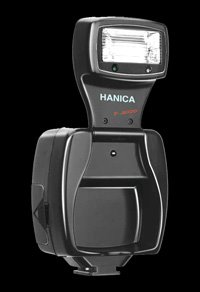cheap slave flashes for wireless multiple flash setups
 After bounce flash, I decided to graduate to bounce flash + slave flash. I hesitated between a 900 bucks setup with dedicated Canon flashes and the thing on the pic right here:
After bounce flash, I decided to graduate to bounce flash + slave flash. I hesitated between a 900 bucks setup with dedicated Canon flashes and the thing on the pic right here:I took the Hanica F-2000. I just love the name; nothing to do with money. Ok, it costs 8 bucks.
The Hanica F-2000 is a slave flash. Before I tell you what slave flashes are and how to use them, here's what they do:
 Effect
EffectIgnore the fact the lighting looks like a Chinese wedding studio shot. You can't expect too much from a Vivitar 3200A (45 bucks) coupled to an 8 dollar Hanica F-2000 — especially when it's the first time ever the photographer is using them. Let's also ignore that only the bag is real in this pic, because that's the point. My magazine was doing a story on fakes (bags, watches, etc.) and I suggested the cover be a girl that used to be a boy—very easy to come by, here in Thailand. Her name is Tina; I don't have her cell number.
Now back to the lights. The Vivitar is doing most of the work, coming in from the left, bouncing off a white board covered with dumb ol' white paper (a white board is too reflective as such, not soft enough). The Hanica's effect is actually pretty discrete on this shot because I've got it under four layers of tracing paper but if you look at her hair on our right, and her arm, there's a glow there that would otherwise be dearly missed. Black hair can end up looking like a flat black cutout if you don't bounce something off it. There was also a big window on that same side that balanced the light on her face. I don't think the Hanica is touching her face because it's obviously giving off a very orange light and her face isn't that color.
The F-2000 is not a powerful device (guide number 11) and there's no way to control its output asides from the old fashion way: moving it away from the subject you’re lighting, bouncing the flash off a wall or rigging some kind of filter or paper directly onto the flash. But as you can see above, it was powerful enough to require 4 layers of tracing paper to dampen it. It's not far out of the frame though, very close to the model. The yellowish paper warmed it up though, which some people would actually do on purpose to create warm highlights in the hair. Personally, I think the whole blue and orange highlights for portraits thing is tacky and could have done with a more neutral color.
Operation
The F-2000 opens up like a clam, which turns it on, after which it can either be used like any old manual flash, by pushing it into your camera’s hotshoe, or as a slave. A slave flash has a light cell that tells it when another flash is firing, at which point it fires as well, in sync. That means you can make just about any light setup you want with them, on batteries (two regular AA’s for the F-2000), and without cables. Just place them somewhere around your subject and watch them all fire when your camera’s flash fires. For the specific placement of the flashes, take a look at the diagram below.

If you’re going to try this, you need to know a few things about your camera’s flash that could create problems for this kind of setup. Digital camera’s TTL (through the lens) measure of flash output are not done like they were with film cameras. Film cameras just shot the flash, measured how much light was bouncing off the film, in real-time, while the shutter was open, and cut the flash when it felt there had been enough light picked up. Digital cameras fire a first short burst of light through the flash, analyze the result, and, immediately after that, fire the flash again with the perfect amount of light to produce the final image. Canon calls it E-TTL, Nikon i-TTL. Let's just use ETTL. Actually it’s just like what photographers do with a flash light meter, except it’s done so fast, your eye doesn’t even see the flash fire twice. It’s a great feature but it doesn’t work with light-triggered slave flash photography.
Your eye doesn’t see the flash fire twice but slaves will; and they will fire on the first flash your camera’s flash fires. When the camera really takes the picture, at the second flash, your slave flashes will be spent. Some cameras might have a setting to tell the camera to not use pre-flash but I can’t find such a thing on my 350D. There is a fix though; just put any old manual flash on your camera. As non-ETTL flashes don’t do pre-flash, they will work perfectly as masters for your slaves. In short, don’t use your built-in flash or any modern ETTL flash for flash slave photography; slap any plain old single burst flash onto your DSLR and you'll be fine.
Models
You don’t even need to have any actual light coming from your camera. You can have an all slave setup with your camera only acting as a remote trigger. That particular trick is not mine so I’ll just link to it; go here. What that link won’t tell you (because it’s trying to sell you a book) is what flashes to use as slaves. You can do what I did, just call up your local shop and ask for one; or, if you’re in the civilized world (where I suspect Hanica F-2000’s don’t exist), you can get a Quantaray - MS-1 ($20) or Sunpak DS-20 ($35). You may also consider slave triggers such as the Wein PN Peanut Photo Slave. It’s $20, just for a trigger (sees the light from the master, triggers the flash it is connected to), but the aforementioned slaves are cheap with reason so it can be worth investing in triggers if you already own quality flashes. You can even attempt to hold on to your built-in ETTL flash as a master with the Phoenix Digital Slave Flash which claims to ignore pre-flash ($48).
Of course, if you own a DSLR, you could do much better with dedicated Canon or Nikon flashes. They’re fully automated and adjustable—meaning you can control the light ratios between groups of flashes from your master flash. They’re a lot more powerful too. Both Canon and Nikon have good tutorials on using their flashes that will leave you wanting not one, not two, but three of them (a master and two slaves). But before you jump the gun, I suggest you give my cheap alternative a shot, just to see if you’re really up to the task of placing the lights, which is the part that can’t be automated and involves time and either a lot of duct tape or three tripods (a good slave flash should have a tripod screw mount). And do ponder this:
| For | Canon | Nikon | any camera |
| Master | Canon580EX ($390) | Nikon SB-800 ($330) | Vivatar 3200A ($45) |
| Slaves (2) | Canon 430EX ($250x2) | Nikon SB-600 ($180x2) | Hanica F-2000 ($8x2) |
| Total price | $890 | $690 | $61 |
If you really don't want to skip on ETTL but still want a cheaper alternative to Canon/Nikon flashes, you might consider Sigma. The Sigma EF 500 DG SUPER (200$) and Sigma EF-500 DG ST ($128) claim to be able to control other Sigma units and do ETTL (that's i-TTL for Nikon to be precise, but it's the same thing really). Just how much control and automation they can do is not really clear on the Sigma website. They come in Canon and Nikon versions. Get them here.
Also, if you don't plan on doing this outside of the comfort of your home, forget flash and get strobes. Although strobes are real studio lights, a studio kit might end up costing you less than dedicated brand flashes that won't work with the camera you'll be using 2 years from today. Strobes work with a ton of cool accessories, are easier to set up, and their output can be controlled. The coolest thing with strobes is they allow you to preview your light setup because they give off light all the time, unlike flashes.
That's it. Now grab a camera, some lights, and shoot away.

1 Comments:
Wow, getting good at this little tutorial thing, aren't we?
Guerrilla photography on a shoestring budget, I likes!
Post a Comment
<< Home